|
22. February, wednesday; 8 PM
composed and performed by:
|

|
|
This work is a result of a workshop formed by
artists from Great Britain, Austria and Hungary.
The aim of this project was to create a transition
between an ancient tradition – the shakuhachi
playing techniques and the attitude towards life
which it characterizes, – and modern technology.
Shakuhachi is a traditional Japanese wind
instrument considered to be able to recall the
whole scale of the nature. Its simple construction
allows extremely complex soundings. The capacity of
the shakuhachi is huge, not only as a musical
instrument due to its variety of colors and special
sounds, but, more so as a link or bridge between
the essential nature of human beings and the
essential nature of the cosmos.
This instrument was favored by swelling numbers of uprooted samurai warriors (ronin) who joined the ranks of itinerant preachers known as komuso ("Priests of Emptiness and Nothingness"). The komuso wore large baskets over their heads to symbolize their detachment from the world. Legend has it that these komuso, forbidden to carry their revered swords, redesigned the shakuhachi from the root of the bamboo making it longer and stouter for use as a club as well as an instrument for spiritual attainment. Mendicant Zen monks who wandered the countryside played the shakuhachi during their pilgrimages, wishing to be delivered from earthly desires. The performance combines the live shakuhachi performance and the real time computer processing. The control of the image and the sound, converting images into sounds and sounds into images were the challenge that the composers and video artists realized from different artistic and technical aspects. |
|
|
|
|
|
23. February, thursday; 8 PM
performed by:
Well-known figure on the international contemporary music circuit, Pamela Z is a San Francisco-based composer/performer and audio artist who works primarily with voice, live electronic processing, and sampling technology. Voci (Voices) is a full-evening, multimedia performance work exploring the sonic, cultural, physical, and artistic worlds of the voice. Written, composed, and performed by Pamela Z, Voci consists of layered, dynamically varied segments incorporating live electro acoustic vocal work with real-time digital processing, vocal samples (triggered with light and gesture controllers), and video (projected and on monitors). The stage is alive with unexpected visual and auditory transformations, and from time to time, Z performs "virtual duets" with some surprise guests who appear in the form of video samples. |
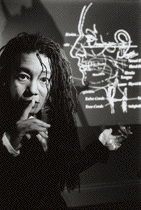
|
| These segments approach voice as anatomy, as character, as identifier, and communicator. Weaving together stories about voice with arias, non-verbal utterances, cries and whispers, choruses of "real" and synthetic voices, and fragments of scientific information, Pamela Z builds a kind of polyphonic mono-opera. | |
|
|
|
|
23. February, thursday; 9.30 PM
composed, programmed and performed by:
"Codespace" integrates realtime drawing and motion-images with electronic sounds that evoke an abstract place where organical and crystalline shapes pulsate and flow. generative (rule-based) processes or algorithms and realtime action by the artist are applied to basic shapes which in conjuction with finely graded colours comprise a rich palette of textures and shapes. |
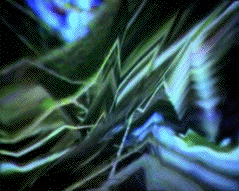
|
| Empty dark space is inhabited by fast moving abstract shapes, structures with an architectural quality develop over extended periods of time. the piece evolves from dark and minimalist atmospheres to abstract densities, like a digital painting performed before the the viewer’s eyes. memory of the images accumulates, obtaining qualities like a painting or etching. reduction and concentration of elements helps to maintain the crucial focus, build the tension and give insights into the enigmatic and invisible world built of code. the lines of flight lead to explorations on shape and colour, choreographic movements and subaquatic flows, plays of lights and surfaces. Coming from a background of improvised music and composed contemporary soundscapes, jasch applies processes to images in much the same way as he does with music. texturing and layering, temporal evolving structures and brief flashes of light play an important role in this abstract visual flow which oscillates and vibrates with a certain musical quality. the interplay between autonomous processes, algorithms and real-time gestural interaction through physical interfaces affects the composition of the pieces deeply. no element is completely prepared or preproduced. the resulting images are surprising, sensuous, sometimes erratic, always with an edge to them. | |
|
|
|
|
24. February, friday; 8 PM
J. Brendan ADAMSON: Four Studies for GuitarBot Robert ROWE: Interactive Piece Mari KIMURA: Polytopia for violin and electronics and interactive graphics Mari KIMURA: GuitarBotana for violin and GuitarBot Frances WHITE: The Old Rose Reader for violin and electronics with projection Conlon NANCARROW: Toccata for violin and electronics performed by:
|
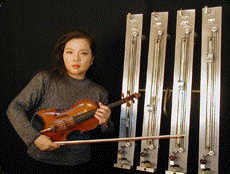
|
|
|
|
|
24. February, friday; 9.30 PM
composed, programmed and performed by:
|
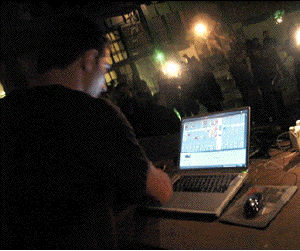
|
|
|
|
|
25. Februar, saturday; 8 PM
performed by:
|
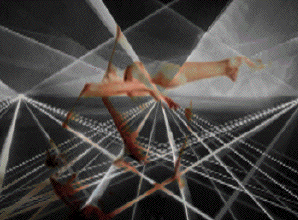
|
|
"Audible Light" is a co-production of Multimedia
Studio of the Planetarium Lasertheatre, the Central
Europe Dance Theatre and Hungarian composers. The
production is based on laser-beams projected into
space, which react to interruption by sending
signals controlling the audio, whereby a unity of
image, gesture and music can be created. The
laser-beam instrument is played by dancers sounding
that way the music created by the composers. It is
possible to bring into life unnumbered
interpretations of the multimedia space. The
concert has been preceded by a workhsop where the
artists of different genres have worked out
together the different versions, the final pieces.
|
|
|
|
|
|
25. February, saturday; 9.30 PM
composed and performed by:
Cècile Babiole, Laurent Dailleau, and Atau Tanaka
create together a dynamic sound/image environment.
S.S.S is a trio performing visual music with sensors
and gestures. They create a work of sound and sight,
a laptop performance that goes beyond with the
intensity of bodies in movement. Going beyond media:
music that is more than a soundtrack, images going
further than video wallpaper. A three-way
conversation modulating sonic and luminous pulse and
flow.
|
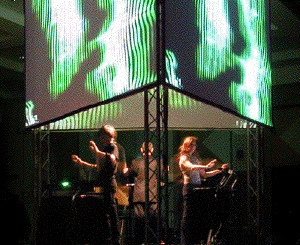
|
| Sensors capture gesture and corporeal
movement, translating them into digital data:
- Ultrasound sensors measure the distance between the performer’s hands and her machine, allowing her to articulate 3D imagery, navigating in color, scale, texture... - The Theremin, historical electronic instrument invented in 1919, an oscillator responds to perturbations of electrostatic fields based on the distance of the hands and body to the instrument... - The BioMuse places gel electrodes on the performer’s forearms, analyzing EMG biosignals. Muscle tension through concentrated movement allows the musician to sculpt sound synthesis. |
|
|
|
|
|
26. February, sunday; 6 PM
Bridges - audiovisual concert on a local network using quintet.net software programmed and conducted by: Georg HAJDU [GER] composed and performed by: Kai NIGGEMANN [GER], Marlon SCHUMACHER [GER], Johannes KRETZ [A], Andrea SZIGETVÁRI [H], Ivana OGNJANOVIĆ [SER] - live electronics quintet.net project website Quintet.net is an interactive network performance environment invented and developed by composer and computer musician Georg HAJDU [GER]. It enables up to five performers to play music over the Internet under the control of a "conductor". The environment, has been programmed with the graphical programming language Max/MSP/Jitter. |
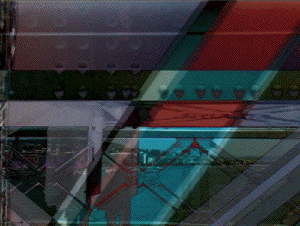
|
|
The players interact over the Internet by sending
musical (control) streams to the server either
using a pitch-tracker for acoustic instruments or
MIDI for electronic instruments. A conductor can
log onto the server and control the musical outcome
by changing settings remotely and sending streams
of parameter values as well as short text commands
to the players. Quintet.net has additional video
and graphical properties, which allows the
realization of full-fledged multimedia pieces.
Quintet.net, a program made by Georg Hajdu,
composer/computer musician, allows to 5 musicians
at any point of the world to play together through
the internet. Performers send actuating data’s to
the server which is sent back - to players and
listeners adjoined by internet -after mixing and
transforming. The quintet.net can control image
processing, such as performance of multi-media
pieces.
|
|
|
|
|
| 26. February, sunday; 9 PM
Closing Concert of the Workshops of the festival |
|
|
|
|